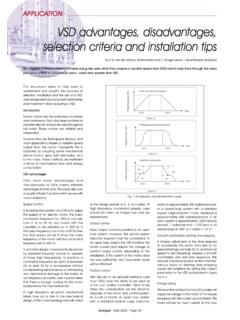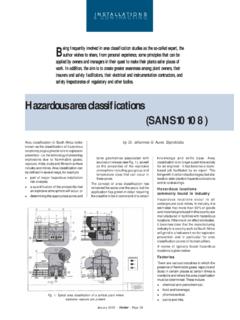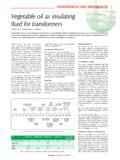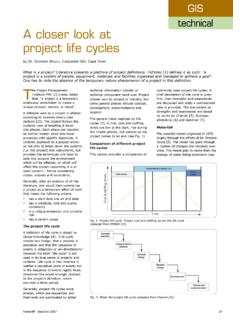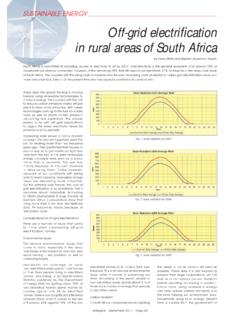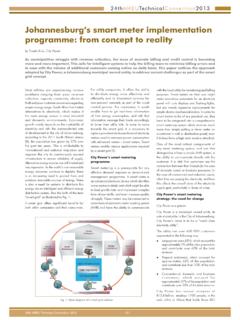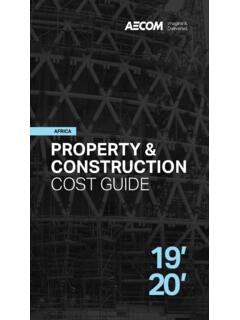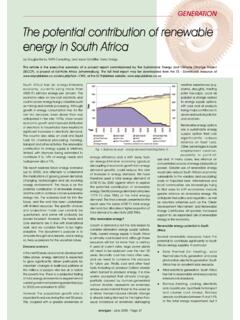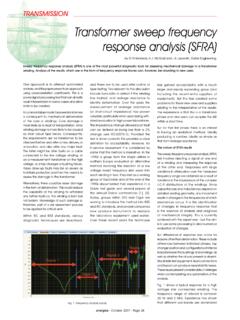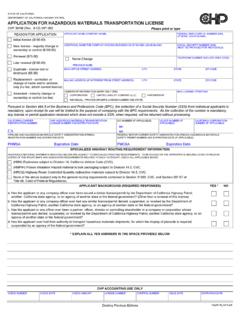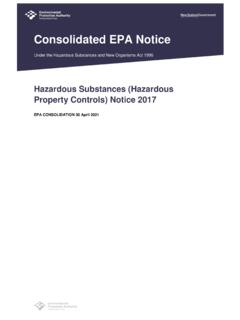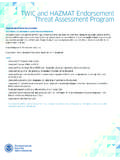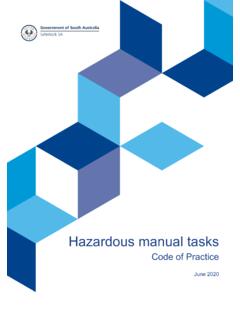Transcription of Hazardous area classifications (SANS10108)
1 January 2005 - Vector - Page 38 INSTALLATIONS& CONTRACTINGArea classification (in South Africa betterknown as the classification of hazardouslocations) plays a pivotal role in explosionprevention the technology of preventingexplosions due to flammable gases,vapours, mists, dusts and fibres in surfaceindustry and mines. Area classification canbe defined in several ways, for examplezpart of major Hazardous installationrisk analysis;za quantification of the probability thatan explosive atmosphere will occur, orzdetermining the appropriate zones andzone geometries associated withsources of release (see Fig.)
2 1), as wellas the properties of the explosiveatmosphere including gas group andtemperature class that can occur inthese concept of area classification hasremained the same over the years, but theapplication has grown in detail requiringthe classifier to be in command of a certainknowledge and skills base. Areaclassification is no longer a part-time activityfor an engineer - it has become a team-based job facilitated by an expert. Thisbrings with it certain disadvantages, but alsoleads to safer plants in Hazardous locationsand to cost locationscommonly found in industryHazardous locations occur in allunderground coal mines.
3 In industry, it isestimated that more than 50% of goodsand materials produced in this country aremanufactured in facilities with hazardouslocations. If the knock-on effect is included,it becomes clear that the manufacturingindustry in a country such as South Africawill grind to a halt were it not for explosionprevention and in particular for areaclassification as one of its main review of typically found hazardouslocations is given are various industries in which thepresence of flammable gases, vapours anddusts in certain places at certain times isinevitable and where the area classificationmust be determined.
4 These includezchemical and petrochemical;zfood and beverage;zpharmaceutical;zpaints and frequently involved in area classification studies as the so-called expert, theauthor wishes to share, from personal experience, some principles that can beapplied by owners and managers in their quest to make their plants safer places ofwork. In addition, the aim is to create greater awareness among plant owners, theirinsurers and safety facilitators, their electrical and instrumentation contractors, andsafety inspectorates of regulatory and other area classifications (SANS10108)by Dr.
5 Johannes G Auret, ExproblabsFig. 1: Typical area classification of a surface plant whereexplosive vapours are 2005 - Vector - Page 39 MinesAlthough coal mines are traditionally theprime focus for explosion prevention dueto the flammability of coal and of methanedust carried by the coal, hard rock minessuch as gold and platinum mines in SouthAfrica have reported the presence offlammable gases (hydrocarbons andhydrogen) on a regular basis in recentyears, accompanied by a series ofdestructive explosions that has led to thestrict application of explosion risk analysisand explosion prevention in this processingplants associated with minesThese plants are categorised separatelybecause of their legal status as beingcontrolled by the Mine Health and SafetyAct and cover a wide range ofpetrochemical and minerals processingplants.
6 Including refineries and of the improved modern-day reagentsused in platinum concentrators are unstableand decompose into flammable products,as a result of which explosion preventionhas been introduced in reagent-handlingplants. Recent incidents in concentratorshave shown clearly that, although safety andexplosion prevention procedures have beendeveloped, these must be improved coal mining, surface crushing plants, coalstorage silos, coal beneficiation plants andbulk handling and loading facilities cancontain Hazardous areas due to theformation of coal dust clouds and thick legal compulsionArea classification is a legally enforcedactivity as shown 4(1)EIR 4(1)EIR 4(1)EIR 4(1)EIR 4(1)
7 No person shall install or permitor require the installation of an electricalinstallation, other than in accordance witha safety standard incorporated into theseregulations under section 36 of the Act,provided that items of an electricalinstallation not covered by such safetystandard and the conductors between thepoint of supply and the point of control shallbe installed in accordance with the by-lawsor regulations of the supplier 8(1)EMR 8(1)EMR 8(1)EMR 8(1)EMR 8(1) No person may useelectrical machinery in locations where thereis danger of fire or explosion owing to thepresence, occurrence or development ofexplosive or flammable articles, or whereexplosive articles are manufactured,handled or stored, unless such electricalmachinery, with regard to its constructionrelating to the classification of the hazardouslocations in which it is to be used.
8 Meets therequirements of a safety standardincorporated for this purpose in theseregulations under Section 36 of the manager shall identifyand define any Hazardous area referred toin regulation 1(11A)(ii) in or on a mine or ata works and record it on a plan or in aregister provided for that a decentclassification (the Do s andDon ts)We know that legally the plant or mine ownercarries the can for area classification. Howdoes he achieve this in practice?Role of ownerIt is fine if the owner wants to carry out hisown area classification, as long as theavailability of in-house competence can bedemonstrated, if necessary in a court of , once a plant is commissioned,explosion prevention is often left in the careof maintenance staff that have an imperfectunderstanding of the , on the other hand, is evenless well informed and is not able toconstructively support these maintenanceefforts.
9 The result is that bad practicesabound and that the statutory requirementsare seldom complied with, including situation will improve once a nationallyrecognized technical qualification thatprovides explosion prevention as aspecialized subject has been established,but due to its multi-faceted nature and thecomplexity of the most current standards tobe applied, the use of external expertise isoften the appropriate , this does not mean for onemoment that the owner can abandonresponsibility for participation in theclassification process!
10 The classificationbelongs to the owner, not a third party thatcomes in and disappears again in the of Hazardous locations shouldonly be undertaken by well experienced,multidisciplinary teams. By definition, theowner knows best about the inner workingsof his plant, and finer details such asmaintenance approach and effectiveness,cleaning methods, use of sampling points,and permit-to-work procedures, to namebut a few, lies with a new plant a typical classification teamcould be made up as follows:zMain engineering constructioncompany: project manager, process,electrical/instrumentation, mechanical,pipingzSubcontractorszClient/ end user/plant owner.
